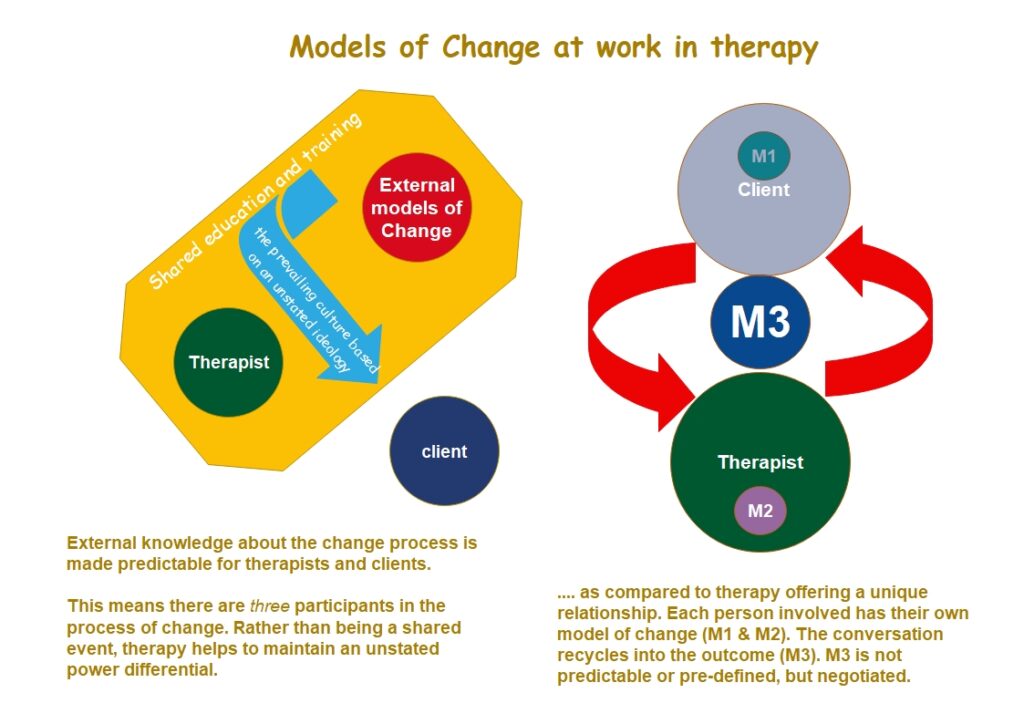‘Science’ uses an approach that is difficult to knock. The stages of the scientific process are not controversial consisting, in summary, of description and exploration, hypothesis testing and model building.
Therefore, science having a central role in therapy should be difficult to knock as well. But it is not. It appears to me that ‘exploration’ through the established scientific experimental method has restricted the world of therapy. I believe it is a category error to place the world of psychological therapy into the world of rational scientific inquiry (as productive as that rationality has been over centuries).
A Category Error
What do I mean by this? Recently, I was able to hear an American Committee debating UFO’s. These are now called Unidentified Anomolous Phenomenon (UAP’s) in order to include arial features that plainly do not fly! A scientist gave a detailed account of how UAP’s are studied in modern times. He made it plain that the more incidents that are studied, the more feasible it is to offer increasingly sophisticated accounts for many thousands of puzzling events. Even then, some remain stubbornly unexplained.
Those UAP events happen ‘out there’ (or do they?). His account showed how it helps to use scientific method to know what goes on but the world gets tricky when I want to study what’s ‘in here’ (as I point to my body). Science can tell a lot about what goes on ‘in there’ when it examines thousands of us.
BUT science struggles to explain how I understand my experiences of what goes on ‘in there’. Some UAP’s are located ‘in there’, it would seem.
A category error happens when I give a label to something better described as something else. What scientists know about the human body, and the things it does, is not the same as my understanding of what I am doing, and what I experience. Consider, for example, the feature known as the ‘placebo’, or its unhappy cousin, the nacebo; seemingly neutral experiences that change create visible change in us. Now we know some of the scientific reasons for seemingly neutral cures that actually heal! Even so, my experience of being healed – by placebos or recognised medicines remain unique to me.
My page on Blind Spots shows humans are sometimes happier to use familiar ‘open doors’ to comprehend our scenic route. We go through that door only to find we make little progress, or meet small defeats in abundance. This deters us from stepping outside our Window of Tolerance (WOT) in a confident way.
A more challenging door might bring the change we want. It is easy to chosen the category of ‘familiarity’ over a rather different category: new opportunities.
That open door provides a category that says: this is the way to go. We do not see other doors that present the potential to go on a road less well travelled. We do not see the target doors or trap doors, as I call them.
As far as the studying the impact of therapy is concerned, scientific inquiry can be a trap door. I am not intending to be rude about ‘science’; even if it sounds like that.
What I am saying is that the science method of inquiry, as it has developed – especially in the Western World – may not offer the best insight into the processes of therapeutic change. For instance, some diagnoses or labels used by professionals are often category errors; they are simply wrong and discovered to be so by further enquiry. This has happened to at least two members of my own family over the years. Other times, diagnoses are category errors because they appear relevant in one set of circumstances, and not in others.
The nature of conventional ‘evidence’ applied to ‘science’ is not best equipped to cast light on our understanding of change. By its nature, change, changes. The fancy word for change, changing, is ‘meta-change’. Ancient Greece gets into every corner of the modern Western world!
There is some anarchy in effective therapy
Taking a ‘photograph’ of a change I may make can be out-of-date within days. Study of the natural order used in many sciences involves change that can take a long time. How long does it take to wear down a mountain chain?! Given the short life span of a human, geological study will reveal a pattern that is susceptible to ordered study. Chemistry and physics have some similarly predictable qualities (until some-one upset the apple cart with Quantum Mechanics!).
…. because therapy is NOT medicine
From this, I can see how the world of medicine has confidence in its own methods of study when it is assessing the impact of ‘treatment’ regimes on their patients. Despite the views of some people, therapy is not medicine; true, it can be about ‘repair’, and some diagnosis, prescription and protocol can help some people in therapy, some of the time.
For the most part, however, therapy can be about choices you want to make. That can have unpredictable consequences. Even so, unpredictable consequences can bring success.
For example, the therapeutic notion of the ‘reframe’ – a change of outlook or attitude – is a change to a pattern in our head. It is not a change in the external world. It not always evident what form that change will take until it happens and, even then, it might change again.
Neuroplasticity
Elsewhere, I touch on the topic, but I want to take it further on this page. In my world, I cannot see that therapy requires organised change; I may see some change coming from a mile off, only to change course when I least expect it.
Scientific experiment, where life-and-limb is at risk, cannot afford to be relaxed about that. medicine and therapy have some things in common; it is evident to me that ‘neuroplasticity’ enables people to recover, at least to some extent, from strokes and brain injuries.
If it can be so, then neuroplasticity can play its part in that ‘reframe’ I mentioned above. Neuro-plasticity is a tricky notion and it does involve the whole brain jiggling all of its parts, not just some, This presents a problem; it’s difficult to see those changes happening, despite modern technology. It is tricky difficult to see how the different parts converse one with another.
If our ‘plastic’ frontal lobes, and lower brain, enable change inside and outside the therapy room, then it’s ill-advised to seek out a single ’cause’ (or variable) of that change. Scientific inquiry, as I understand it, rather depends on the control of variables.
What’s so special about therapy?
It seems to me that there is something special about the therapy room; it offers something that is different – not easily found in other areas of our lives, e.g. it offers some time for non-judgmental reflection by (at least) two people. This quality brings art to therapy as well as science. It starts with some values; art and science both have them but consider this: what is non-judgmentalism? I am not supposed to impose my judgments upon the person in front of me; it’s a rule of therapy.
Science requires the converse – ‘good’ judgment in the design and implementation of the ‘good’ scientific experiment is essential. That judgment is informed by my more experienced or senior colleagues. Scientific inquiry, like most relationships in the ‘outside’ world, involve at least two egos negotiating their way around conflicting interests – until some-one with authority decides what to do! By contrast, ‘good’ therapy depends on creating a very unusual relationship – one in which wisdom, curiosity and hope are shared – and the best outcomes arise when the ‘client’ decides on the change to nurture.
This leads me to conclude that skill and knowledge alone are insufficient to get a good result in therapy. Solicitors, doctors, engineers and shop keepers – amongst others – have plenty of skills and knowledge. It’s not even that the knowledge and skills of therapists will be central to an effective outcome. Knowledge and skills can make a difference to therapy outcomes, but only so far.
Two egos working it out
This illustration, below right, demonstrates how an effective therapeutic relationship can meld those two egos into a very different working alliance.

This melding can swim against the tide. Conventional learning rather assumes that the left-hand side of the illustration creates a constant tension undermining the collaborative relationship: you-and-me.
It’s a meld that respects who can contribute what by shaping and respecting boundaries between one another. It does this negotiation best when those boundaries are formed without laying claim to the territory. In the outside world there are different boundaries between you and me.
Uncertainties in our world can foster conscious or unconscious temptations to claim territory to ensure control over events. In the everyday, it is too easy simply to put our blanket on the ground and claim it as our own. The blanket may be yours, but the earth underneath it, is not. One of the problems with model building is the temptation to lay claim. This is fine if you are all spread out on a large exapanse of beach such as Rhossili on the Gower Peninsula in South Wales (gorgeous place!), but not so helpful at Brighton in July and August.
Even at Rhossili our otherwise natural drive for control can be an abuse of power. It takes discipline to avoid such abuses and many folk fail at the task (including me).
In the wider world, our society has the police to help sustain those boundaries; in the world of therapy it is an unknown that needs attention.
Here’s a page with little to say about small, safe experiments. It’s a page of opinion and you can accept as little or as much as you wish. It contains general points that may still help you with the design and implementation of your own experiments. I’m reluctant to end with nothing practical to offer, so let me end with an example.
A practical example
Recently, I was talking with some-one about sleep management. They told me that they had read somewhere that it was not sensible for anyone struggling with their sleep to exercise late in the evening or in the night. Now that advice has some sense. The body is slow to adapt, and it needs time to absorb the benefits of exercise. Therefore, manuals recommend gentle exercise in the early evening, but not later on.
In discussion with this person, I discovered that this person had used late-night exercise to some good effect. She had walked up and down the corridors in her house. In practice, she believed that it had helped her. Please note, believed. ‘Belief’ may be enough and sufficient to generate change – without any research study to prove whether this was so or not.
Reading the advice, based on reasonable scientific findings, was not bad thing in itself, except that it deterred this person. Things in print do seem to have more authority, do you think?!
That’s a shame in my view as the advice in print may not be so helpful as we think. I trust she is going back to her own experiment just noticing what the outcomes are over a period of time.
By the way, I do a few minutes of puzzling on my smartphone most nights as I settle for sleep. Works for me but that’s another device that’s not recommended!
END RESULT: IF IT WORKS, DON’T KNOCK IT
Do more of what appears to work; make decisions about stopping a small, safe experiment only when you have noticed that there is no evident good result for you.
Other leads to consider
Designing a small, safe experiment
Actions that may qualify as safe experiments
